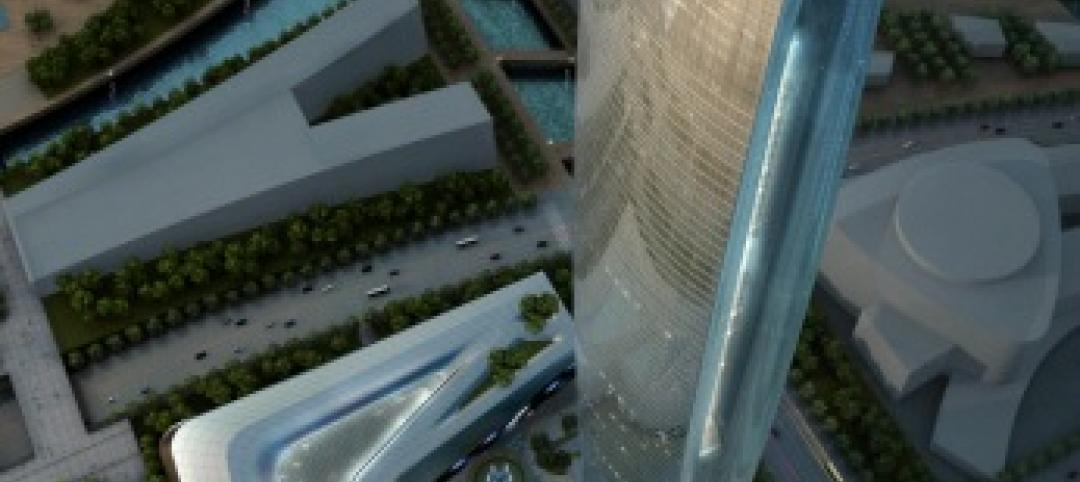In the last six years, the University of Arkansas for Medical Sciences, in Little Rock, has experienced unprecedented growth, including the development of more than $425 million in new or expanded facilities. UAMS is Arkansas’s only comprehensive academic health center, with five colleges, a graduate school, a new 550,000-sf hospital tower (completed in 2009), six centers of excellence, and a statewide network of regional centers. It’s also the state’s largest public employer, providing jobs to more than 10,000 Arkansas healthcare professionals.
But by 2009 all of that growth was taking its toll on the campus’s existing data centers, which had to securely store most of the hospital system’s sensitive medical records.
“In the last five years we’ve had about 35% growth,” said Mark Kenneday, UAMS’s Vice Chancellor of Campus Operations. “Our old main data center was pretty crude, a reflection of the growth we experienced.” The medical center’s IT infrastructure program, he explained, was being developed around the idea of a three-legged stool, with redundancies in all three data centers; if any single location were to go down, another of the centers could pick up the slack.
However, only two of the data center “legs” were in place. Clearly, a new primary data center was needed. That’s when building information modeling came into play.
Rather than just plan and construct another building to house massive racks of servers for a quick fix, Kenneday and the operations team at UAMS looked at the new data center as an opportunity to expand the university’s BIM design standards and create a building that would efficiently serve the UAMS campus for at least the next hundred years.
Even before Kenneday arrived at UAMS in 2007, the medical center required Building Teams to submit designs in Autodesk’s Revit BIM platform. But the Primary Data Center project expanded the 3D BIM requirement in its contracts and bid documents to the entire Building Team. All general contractors had to bid the project as a BIM carry-through. BIM precertification was also required of every architect and engineer on the project.
“We really pushed them into a corner so they would take the responsibility,” Kenneday said. “We already had all of our schematic designs done in BIM. A more profound delivery was a very natural next step. When you realize you have this giant data repository you don’t know what to do with, the BIM model allows you to put some of that information into data knowledge for decision-making down the road.”
MEP and structural design engineer TME Engineering, Little Rock, led the design team for the $4.9 million, 15,000-sf PDC with Kirchner Architecture, also of Little Rock, providing the architectural design. Kenneday said that, notwithstanding the importance of the architectural aspects of the building, it was the information stored inside the PDC that was “vitally important” to the university, which is why the engineers were given primacy on the design team.
In addition to requiring an efficient power usage efficiency (PUE) rating of 4.0 for the project, UAMS further demanded that the Building Team turn over its completed models for use in managing the facility management and providing emergency first response once the building was completed.
“When they deliver their BIM model, it becomes a UAMS product,” Kenneday said. “It becomes a part of our OEM delivery. We’ve just now started to get a repository of BIM information for our latest projects. We have a unique position here in Little Rock, in that we’re the big dog when it comes to healthcare construction, so we can do that.”
TME and Kirchner delivered a design that featured a portfolio of engineering systems: variable volume air handling units to condition the air in the Primary Data Center’s raised floor area, hot aisle enclosures to minimize cold air bypass, a dedicated ventilation unit to provide humidity control, and a chilled water system—in fact, a variable primary low-flow, high-delta-T chilled water system with energy-efficient water-cooled chillers. The heat from the data center’s raised floor area is transferred from the chilled water system to the heating water system using a heat pump chiller/heater; it then is used to heat other buildings on campus.
“We were going for a high energy rating and part of that was helped by the BIM process,” said Mark Mergenschroer, BIM development coordinator at TME. “Architectural, MEP, and structural models were all done in Revit, and it was a learning process for some of the team, since this was the first full BIM project in Arkansas. Was our model perfect all of the time? No, but the team effort and the process was.”
General contractor Vratsinas Construction Co., Little Rock, worked with its subcontractors to provide detailed shop drawings based on information from the Revit models. Project stakeholders and Building Team members could virtually walk through the planned data center and comment on the design thanks to a virtual model made in the Unity 2 gaming engine. (To try the walk-through, go to: http://www.tmecorp.com/unity2.)
The project was completed on schedule and opened last October, 18% under budget. TME was able to beat the university’s PUE target of 4.0, bringing the project in with a PUE rating of 1.36. More importantly, the data center can increase its storage capacity as UAMS continues to grow. The initial buildout uses only about 50% of its server capacity, with the ability to add another 50% as IT services are expanded. The final Revit models are being used for facilities management and planning new UAMS infrastructure.
That capacity will be needed, as the period of growth has not finished at UAMS. Construction started last year on a four-floor expansion to the Donald W. Reynolds Institute on Aging, an existing, four-story Alzheimer’s disease research and treatment facility on the Little Rock campus. Planning is also under way to renovate 24,000 sf in the former main hospital building for the new UAMS Center for Clinical and Translational Research. Both projects use the same BIM requirements used on the Primary Data Center.
“I would prefer for our campus to take a lead position when it comes to BIM,” Kenneday said. “We want to be on the front of the train, rather than on the back. Or under it.” BD+C
Be sure to catch the latest blog from Jeff (“BIMBoy”) Yoders at: www.BDCnetwork.com.
Related Stories
| Jan 24, 2012
U of M installs new lighting at Crisler Player Development Center
Energy efficient lighting installed at PDC reduce costs and improves player performance.
| Jan 24, 2012
Rockingham County Judicial Center receives USGBC Gold NC v.2.2
The Rockingham facility is the first judicial center in North Carolina to seek certification from the U.S. Green Building Council’s LEED Building rating system.
| Jan 19, 2012
LEED puts the 'Gold' in Riverside golden arches
McDonald's restaurant recognized for significant energy savings.
| Jan 19, 2012
Odebrecht and Braskem bring sustainable award to U.S. university students
The Odebrecht Award for sustainable development rewards future leaders in engineering and chemistry.
| Jan 19, 2012
BOKA Powell-designed facility at Texas A&M Bryan campus
The new facility provides programs for the Texas A&M Health Science Center, the Texas Brain and Spine Institute, Mary Crowley Cancer Research Centers, and Blinn College Allied Health programs.
| Jan 17, 2012
SOM Chicago wins competition to design China's Suzhou Center
The 75-level building is designed to accommodate a complex mixed-use program including office, service apartments, hotel and retail on a 37,000 sm site.
| Jan 17, 2012
FxFowle and CO Architects form joint venture
FxFowle and CO Architects creates a dynamic alliance built on a shared dedication to collaboration in process, innovation in programming, and excellence in design.
| Jan 17, 2012
Capital Engineering joins AECOM
With 160 employees based in Taipei and Kaohsiung, CEC specializes in environmental, water, hydraulic and land development engineering consulting services for clients in Taiwan's public and private sectors.
| Jan 17, 2012
SOM launches Los Angeles design studio
Expert team to join the firm's West Coast practice, focusing on innovative urban and environmentally sustainable design in Southern California
| Jan 16, 2012
2012 40 Under 40 applications due Friday, Jan. 20
Building Design+Construction's 40 Under 40 is open to AEC professionals from around the world who are under 40 years old, as of January 1, 2012.

















